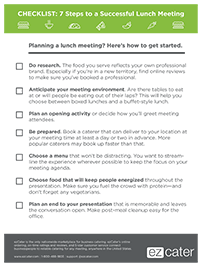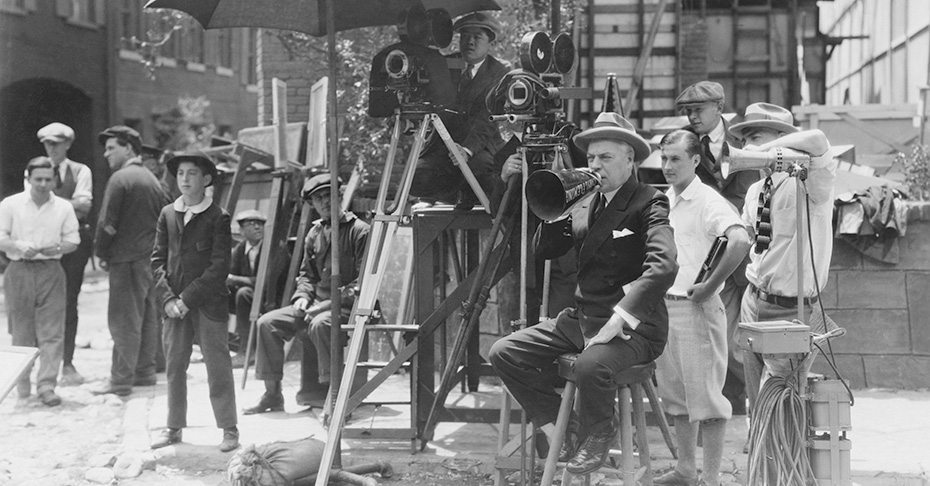We’ve all seen this movie before. You’re already on the fence about attending a lunch meeting. When you show up, the food’s late, or messy to eat, and the whole ordeal seems like a waste of time, for both you and the presenter.
Getting and keeping your audience’s attention during a meeting can be tough, especially over a meal. Like making a movie, making lunch meetings work to your advantage is an art and a science. How do you choose food that’ll keep your audience focused? And how do you set your meeting up to be relevant and memorable? Movie directors don’t rise to the top without a whole lot of focus—the same goes for salespeople.
With practice, and the right information, you can take your lunch meeting game from straight-to-DVD flop to Hollywood blockbuster. Here’s how.

Download our checklist:
Mise en Scene: Be Prepared
Of all of the priorities on your to-do list, arranging catering probably falls somewhere near the bottom. Sometimes, though, showing up with food is the key that gets you in the door. But your presentation is the reason you’re there—and prepping for it is a lot of work. It’s easy to let the food become an afterthought.
Try to resist the urge to throw together a menu at the last minute. Planning an effective lunch & learn means planning the entire experience: from the topic you’re presenting to the meal itself. Remember: the food you serve will reflect on your own professional brand. It’s probably not a good idea to show up at a client’s office with three-day-old bags of fast food. On the flip side, the meal shouldn’t be so elaborate that it distracts from your presentation. Serving the right meal can make the difference between having a focused and engaged audience or a drowsy and irritable one.
Do Field Research
In any situation, it’s a good idea to start with as much information as possible. Seek out online reviews of the caterers you’re considering to check their reputation for professionalism, on-time delivery, and consistent food quality. You’ll want a caterer that has a proven track record for paying attention to details. The meal you serve reflects your own level of professionalism. The last thing you want to deal with before taking the stage is hunting down the silverware or napkins your caterer forgot. Confirming the delivery details with your caterer the morning of the event is a good way to check that everyone’s on the same page.

Optimize Everything for Focus
The food you serve should not only be tasty and professionally presented, it should also provide your audience with macronutrients that help them stay alert, energized, and engaged. You’ll also want to consider your presentation environment. Are there tables in the room, or will people huddle around and eat out of their laps? If you’re not sure, ask. This will help you decide whether to opt for a more portable option, like a boxed lunch. In any situation, avoid serving foods that are messy or difficult to eat in front of a group. You want your audience focused on you and your topic, not whether their faces are covered in barbecue sauce.
Here are some quick ways to effortlessly weave food into the fabric of your meeting:
- Choose a menu that won’t be distracting. Providing a simple menu allows you to kick off the meeting faster—it’s a lot easier to weigh three sandwich options than thirty. You want to streamline the experience wherever possible to keep the focus on your meeting agenda. The food you serve should fuel your objective, not replace it.
- Plan an opening activity or roundtable discussion. This gives the audience time to get settled and start eating, while keeping them engaged in discussion. It also allows you a bit of time to build rapport and keeps the typical “pass the salt” distractions to a minimum.
- Choose foods that promote focus, energy, and mental clarity. You want to fuel your meeting with foods that keep your audience alert and focused, without making them crash halfway through the meeting:
- Dark chocolate is a great option, providing just enough caffeine to keep your audience alert, without the jitters often associated a coffee overload.
- Turkey, chicken, or salmon all provide protein, which staves off “hangriness,” stabilizing blood sugar and increasing energy. For vegetarians, don’t forget to provide a source of protein like beans, nuts, or tofu.
- Almonds are easy-to-eat nutritional powerhouses that reduce hunger and keep your audience alert throughout the meeting.

Lights, Camera, Action
The best movies start with a good script. After you plan your menu and put those finishing touches on your presentation, spend some time envisioning how the lunch & learn or sales meeting should go. The most effective and profitable meetings are scripted for success, and you’re in the director’s chair. Consider the following:
- How and by whom you’ll be introduced. If someone else will introduce you, send a short bio in advance so you have influence over the messaging.
- Whether or not you’ll eat with your audience. There are no hard and fast rules, but you should make sure your attendees get enough food before you make a plate.
- Start and stop times for the presentation itself. Be sure to start and end on time, or you may mess with your host’s schedule.
- Nothing’s worse than a movie without an ending. Figure out exactly how you’ll close the meeting, and what you can do to keep your audience engaged after you leave.
If you’re armed with the right tools, and show up prepared, your audience will be discussing your presentation long after the credits roll. It’s up to you to make the most of it.
Need catering for an upcoming meeting? Don’t put it off till tomorrow.







